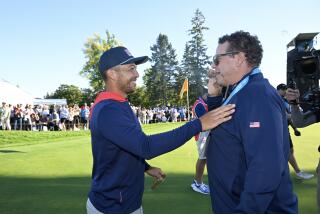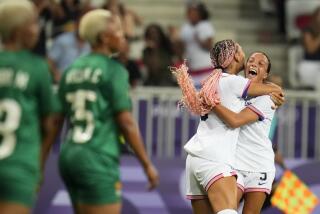Tennis : Although U.S. Team Has New Look, Clay Courts Seem the Same
- Share via
After the United States lost to West Germany in July, the would-be Davis Cup savior, John McEnroe, put his American flag into storage and delivered a summation on the lost weekend in Hartford, Conn.
“It’s not my idea of fun to go and play in Bolivia,” McEnroe said of the American zone competition. “But, you’ve got to do what you’ve got to do.”
The United States team went to Peru instead, with a new look in an old venue, those beloved South American clay courts. This time, however, the absence of Mac, didn’t hurt as the United States beat Peru, 3-2, in Lima last weekend. The Americans led, 3-0, after three days but decided to default the final two singles matches which were scheduled for Monday.
With the luck being so lousy in South America lately, the American contingent couldn’t be blamed for wanting to get away as fast as possible. And, as for the future, no one is in a big hurry to go back. U.S. Davis Cup captain Tom Gorman wasn’t too eager to talk about the next test in July against Argentina. At least not yet.
“I’m still savoring this win,” he said. “I read afterward in the newspaper that it’s been 21 months since we won a Davis Cup match. We can savor this one for a while.”
He was talking about July, 1986, when the United States won at Mexico. Since then, the Americans have lost matches to Australia, Paraguay and West Germany, the latter causing the demotion to zone play. At the earliest, the United States won’t be eligible for the Davis Cup until 1989.
But, before the attention turns to playing the American zone final in Argentina--which has two formidable clay-court players, Martin Jaite and Guillermo Perez-Roldan, both ranked in the top 30--a look back to last weekend is in order.
In Lima, Gorman went with a new and younger look, partially out of necessity. He picked 17-year-old Andre Agassi, who is ranked No. 15 in the world, and 21-year-old Jay Berger, who is ranked in the top 40, to accompany the veteran doubles team of Ken Flach and Robert Seguso.
Agassi was not a surprising pick because of his outstanding play the first three months of 1988. Berger, however, was less obvious even though he recorded a recent victory over No. 2-ranked Mats Wilander, and Gorman realized that the general tennis public wasn’t aware of Berger.
“What we are really doing is going in the direction of a new look, but not just for the sake of it,” Gorman said prior to the Peruvian match. “These guys are playing very, very good tennis. The Peruvians are going to be aware. I think the choices took people by surprise.”
Which, proved to be somewhat prophetic. After Berger’s Davis Cup initiation on the opening day, a near six-hour match against Pablo Arraya, Gorman was surprised by the tenacity his player showed in a 7-5, 6-1, 5-7, 1-6, 7-5 victory. The win gave the United States a 1-0 lead and, more importantly, a lot of momentum.
“For your first Davis Cup match to last six hours . . . in that kind of situation (in amazing),” Gorman said. “Jay showed me everything that people had told me about Jay Berger. . . . The biggest unknown in my mind was that it might be too tough a place to indoctrinate the guys in Davis Cup play. I had no doubts about their (Agassi’s and Berger’s) abilities. Berger’s effort, in basically a six-hour match, just kind of solidified everything I’ve been feeling about both those guys. I’m relieved and very proud of both those guys.”
Berger said it was the toughest conditions he had even played under. Flach and Seguso, veterans of the adventure in Paraguay, disagreed, saying the conditions in Peru were more like playing in Japan, where the fans watch and don’t participate as they did in Paraguay. Gorman said that it was something in between.
“As far as he (Berger) was concerned, it was the ultimate,” Gorman said. “It gets loud. But we had such an extreme last year. It’s all relative.”
Agassi, unlike Berger, started slowly against Jaime Yzaga in their match, which started Friday and was stopped at 5-5 in the first set because of darkness. Although Agassi lost the first set when play resumed on Saturday, he fought off the nerves and started to make the points last longer, eventually winning in four sets.
“Yzaga’s supposed weakness is his forehand,” Gorman said. “He loves to control the points with his backhand, and all of a sudden against Andre, he hasn’t missed a forehand in two sets, and his backhand is even stronger. We felt it was really a matter of time before it broke down. That’s what I was telling Andre.”
The win in the second singles match put the United States in an unfamiliar position leading, 2-0. It also placed Flach and Seguso in a new spot, they could clinch the match. This realization left the duo strangely flat.
“It was the flattest I’ve ever seen Ken and Robert start off,” Gorman said. “They weren’t reacting emotionally to the crowd. If anything, I usually have to calm them down. This time I had to fire them up. I was yelling at them and telling them that they were playing awful. I was trying to get them emotional at me, at least.”
Flach and Seguso won in four sets, and, barring anything out of the ordinary, are a virtual certainty to play in Argentina in July.
As for McEnroe, who knows? He told Gorman before the match against Peru that he wanted to really be physically ready the next time he plays Davis Cup for the United States.
“He told me, ‘I’ll be ready for Argentina,’ ” Gorman said before the U.S.-Peru match.
So what was Gorman thinking about who to play in the two singles matches against Argentina?
“Don’t even ask the question,” Gorman said. “It’s better if you don’t even ask.”
After 21 months sans success in Davis Cup, Gorman certainly couldn’t be blamed for not wanting to look ahead especially after everyone has been looking back for such a long time.
Tennis Notes:
Ron Bookman, 46, deputy executive director of the Assn. of Tennis Professionals, died last week when a car struck him as he rode his bicycle across a city street in Dallas. . . . Super sub: UC Irvine’s Trevor Kronemann filled in at No. 1 singles when the Anteaters’ top player, Mark Kaplan, had a cold two weeks ago. And, Kronemann rose to the occasion--actually, a bit of an understatement--and defeated No. 4-ranked Scott Melville of USC, 6-1, 1-6, 7-6, and No. 8 Greg Failla of Cal State Long Beach, 6-1, 6-1. In the latest individual rankings, Kaplan is No. 13, while Kronemann is No. 51. . . . USC, which defeated UCLA, 6-2, a week ago last Saturday, is ranked No. 3 among men’s teams, a drop of one position. Other California teams in the top 10 are Stanford (No. 1), Pepperdine (No. 4), UC Irvine (No. 6) and UCLA (No. 9). Florida remains at the No. 1 spot in the women’s rankings, followed by Stanford, USC, UCLA and California. Pepperdine is No. 16, while San Diego State is 19th. Miami senior Ronni Reis is the top-ranked individual. Trisha Laux, a freshman at USC, has moved to No. 5. Two other local players, Ginger Helgeson of Pepperdine and Kirsten Dreyer of UCLA are ranked in the top 15.
The TeamTennis professional draft was held last week in Chicago for the 8-team, 32-player league, which is July 6-Aug. 7. The complete league roster--Charlotte Heat: Elna Reinach, Monica Reinach, Eddie Edwards, Tim Wilkison; Fresno Sun-Nets: Rosie Casals, Sandy Collins, Francisco Gonzalez, John Letts; Los Angeles Strings: Penny Barg, Elise Burgin, John Lloyd, Leif Shiras; New Jersey Stars: Jenny Byrne, Belinda Cordwell, Peter Fleming, Matt Mitchell; Portland Panthers: Dianne Balestrat, Sharon Walsh Pete, Marcel Freeman, Andy Kohlberg; Sacramento Capitals: Mary Lou Daniels, Barbara Gerken, Ricardo Acuna, Robert Van’t Hof; San Antonio Racquets: Beverly Bowes, Candy Reynolds, Eric Korita, Nduka Odizor; South Florida Breakers: Heather Ludloff, Susan Mascarin, Claudio Panatta, Blaine Willenborg.
More to Read
Go beyond the scoreboard
Get the latest on L.A.'s teams in the daily Sports Report newsletter.
You may occasionally receive promotional content from the Los Angeles Times.











